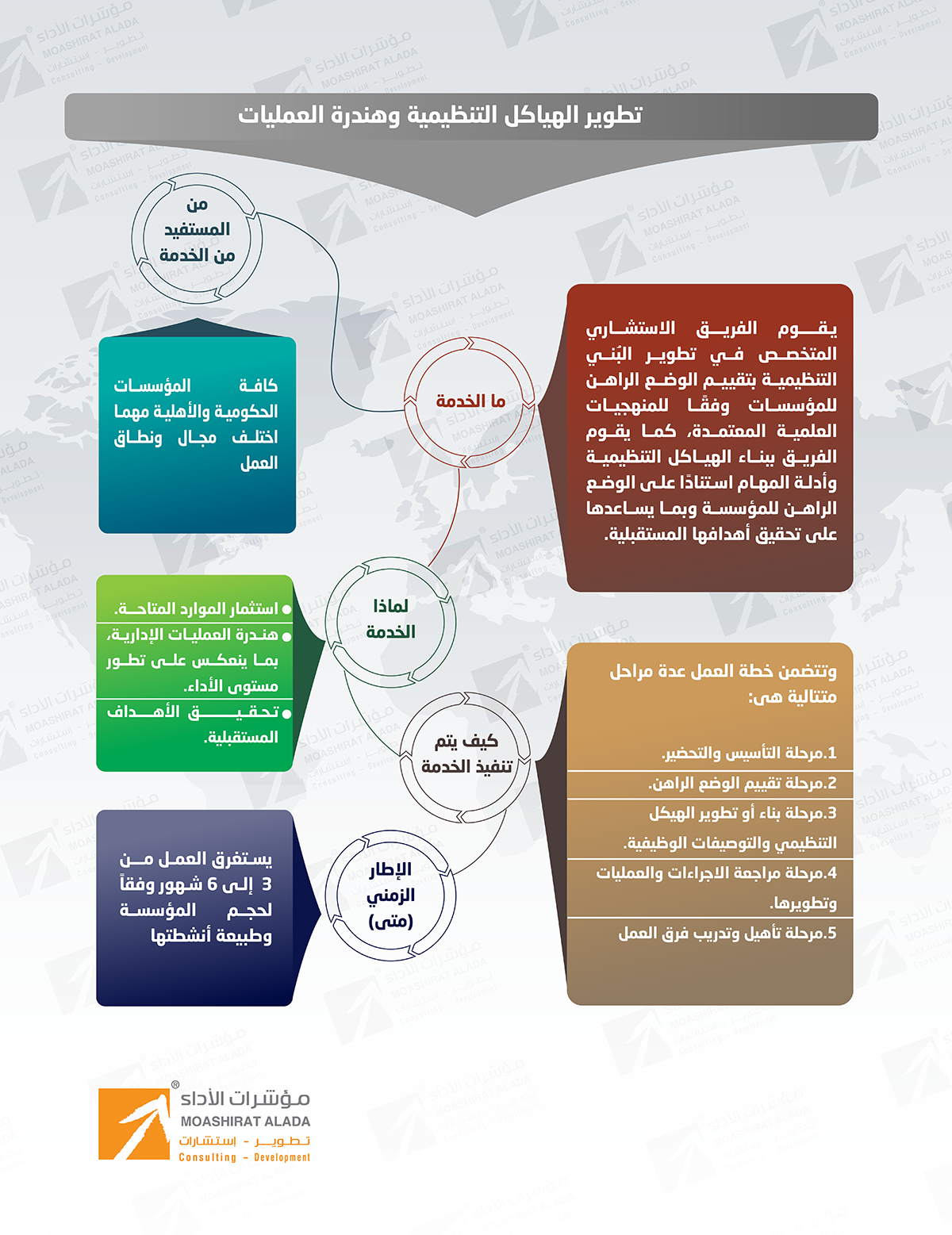Development of organizational structures and operations
We proceed from internationally approved methodologies in the development of organizational structures and procedures and procedures, which helps institutions ensure the investment of all material and human resources available and the trend towards achieving current and future goals.
The organizational structure development methodology is based on collecting opinions, observations and views of the organization's employees through direct meetings or workshops and meetings.
The process of developing organizational structures depends mainly on the participation of the senior leaders in the organization at all stages of the development process, ending with a comprehensive organizational structure capable of achieving the objectives and strategic directions of the institution.
the challenge
A structured organizational structure with a set of tasks, responsibilities and powers ensures that the organization invests all its resources, supports the success of its current operations and launches towards a promising institutional future.
Solutions
- Professional assessment of the regulatory work environment.
- Comparison and reference to similar international experiences.
- Building the operational model of the organizational structure.
- Review and develop processes and procedures.
- Building job descriptions that support institutional success.
- Electronic solutions supporting successful operations management and business processes.
Results
- Invest all available enterprise resources.
- Management processes are managed, reflecting the evolution of performance.
- Eliminate duplication of work.
- Ensure future objectives and operational initiatives are achieved.
- Outstanding institutional reputation.

Our service strategy
Our strategy is in the following business stages
1- Study and evaluation
Phase I: Study and evaluation of the current situation The field of work is as follows:
- Collection and analysis of information available to the Authority (eg, decision of establishment, laws and regulatory decisions, strategic plan, previous organizational structures (if any), ....).
- Holding interviews with the relevant authorities to verify the accuracy of the information collected, and can also use questionnaires, both paper and electronic.
- Analysis of the current organizational structure, through the use of methods and methods of organizational analysis, analysis of the following aspects "strategy and performance management, current organizational structure, human resources, intercom, techniques, policies and procedures."
- Analyze current job profiles for all employees.
- Develop organizational recommendations and options.
2- Building the structure
- Phase II: Building the Organizational Structure and Job Descriptions The field of work is as follows:
- Benchmarking and basing on similar international experiences in the structure to take advantage of those experiences in emerging new structure developed.
- Prepare the operational model (a representation of how the organization works through the interconnection of its activities to achieve its function).
- Building or developing the organization's current organizational structure through the use of methods and methods of organizational analysis (identification of work activities, identification of organizational relationships, defining the functions and responsibilities of organizational units, preparation of detailed organizational structure.
- Provide the proposed structure for the management of the beneficiary (for the presentation and adoption of observations and observations)
- Prepare job description cards for all employees.
To ensure the success of the organization and its new or developed structure:
The RAG reengineering the processes (management processes) in order to harmonize organizational changes by reviewing all procedures and administrative processes carried out within the entity by examining the current state of operations, listening to customers, reviewing the successful benchmarking models, , Implementation and continuous improvement), and contribute to the development of administrative processes and not administrative activities and to achieve operational efficiency, and the rapid delivery of services, and increase customer satisfaction, and reduce the cost.
3- IT Solutions
Phase III: Electronic Solutions
It offers a range of e-solutions that the organization can choose from, and ensures e-solutions manage tasks, business and processes, as well as follow-up institutional performance.
4- Awareness and training
- Stage 4: Awareness and training
In which awareness and training programs are provided to spread the culture of institutional work and give the administrative leaders the necessary skills.
5- Advisory support
In order to ensure that the institution continues to implement its strategy optimally, the consultant team will provide support for a period of one to three months, through a series of field visits to assess the implementation of the indicators and the challenges facing implementation and provide the advisory opinion for improvement and development.
Request This Service
Please fill the bellow form to complete the request
